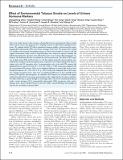| dc.contributor.author | Wang, Xiaobin | |
| dc.contributor.author | Wang, Lihua | |
| dc.contributor.author | Yang, Fan | |
| dc.contributor.author | Tang, Genfu | |
| dc.contributor.author | Xing, Houxun | |
| dc.contributor.author | Lasley, Bill | |
| dc.contributor.author | Overstreet, James W. | |
| dc.contributor.author | Stanford, Joseph B. | |
| dc.contributor.author | Chen, ChangFeng | |
| dc.contributor.author | Ryan, Louise Marie | |
| dc.contributor.author | Xu, Xiang | |
| dc.date.accessioned | 2011-09-13T04:14:23Z | |
| dc.date.issued | 2005 | |
| dc.identifier.citation | Chen, Changzhong, Xiaobin Wang, Lihua Wang, Fan Yang, Genfu Tang, Houxun Xing, Louise Ryan, et al. 2005. Effect of environmental tobacco smoke on levels of urinary hormone markers. Environmental Health Perspectives 113(4): 412-417. | en_US |
| dc.identifier.issn | 0091-6765 | en_US |
| dc.identifier.uri | http://nrs.harvard.edu/urn-3:HUL.InstRepos:5129842 | |
| dc.description.abstract | Our recent study showed a dose–response relationship between environmental tobacco smoke (ETS) and the risk of early pregnancy loss. Smoking is known to affect female reproductive hormones. We explored whether ETS affects reproductive hormone profiles as characterized by urinary pregnanediol-3-glucuronide (PdG) and estrone conjugate (E1C) levels. We prospectively studied 371 healthy newly married nonsmoking women in China who intended to conceive and had stopped contraception. Daily records of vaginal bleeding, active and passive cigarette smoking, and daily first-morning urine specimens were collected for up to 1 year or until a clinical pregnancy was achieved. We determined the day of ovulation for each menstrual cycle. The effects of ETS exposure on daily urinary PdG and E1C levels in a ±10 day window around the day of ovulation were analyzed for conception and nonconception cycles, respectively. Our analysis included 344 nonconception cycles and 329 conception cycles. In nonconception cycles, cycles with ETS exposure had significantly lower urinary E1C levels (β= –0.43, SE = 0.08, p less than 0.001 in log scale) compared with the cycles without ETS exposure. There was no significant difference in urinary PdG levels in cycles having ETS exposure (β= –0.07, SE = 0.15, p = 0.637 in log scale) compared with no ETS exposure. Among conception cycles, there were no significant differences in E1C and PdG levels between ETS exposure and nonexposure. In conclusion, ETS exposure was associated with significantly lower urinary E1C levels among nonconception cycles, suggesting that the adverse reproductive effect of ETS may act partly through its antiestrogen effects. | en_US |
| dc.language.iso | en_US | en_US |
| dc.publisher | National Institute of Environmental Health Sciences | en_US |
| dc.relation.isversionof | doi:10.1289/ehp.7436 | en_US |
| dc.relation.hasversion | http://www.ncbi.nlm.nih.gov/pmc/articles/PMC1278480/pdf/ | en_US |
| dash.license | LAA | |
| dc.subject | environmental tobacco smoke | en_US |
| dc.subject | estrone conjugates (E1C) | en_US |
| dc.subject | pregnanediol-3-glucuronide (PdG) | en_US |
| dc.subject | prospective study | en_US |
| dc.subject | urinary hormone levels | en_US |
| dc.title | Effect of Environmental Tobacco Smoke on Levels of Urinary Hormone Markers | en_US |
| dc.type | Journal Article | en_US |
| dc.description.version | Version of Record | en_US |
| dc.relation.journal | Environmental Health Perspectives | en_US |
| dash.depositing.author | Chen, ChangFeng | |
| dc.date.available | 2011-09-13T04:14:23Z | |
| dash.affiliation.other | HMS^Genetics | en_US |
| dash.affiliation.other | SPH^Biostatistics | en_US |
| dash.affiliation.other | HMS^Pathology | en_US |
| dc.identifier.doi | 10.1289/ehp.7436 | * |
| dash.authorsordered | false | |
| dash.contributor.affiliated | Xu, Xiang | |
| dash.contributor.affiliated | Chen, ChangFeng | |
| dash.contributor.affiliated | Ryan, Louise | |


